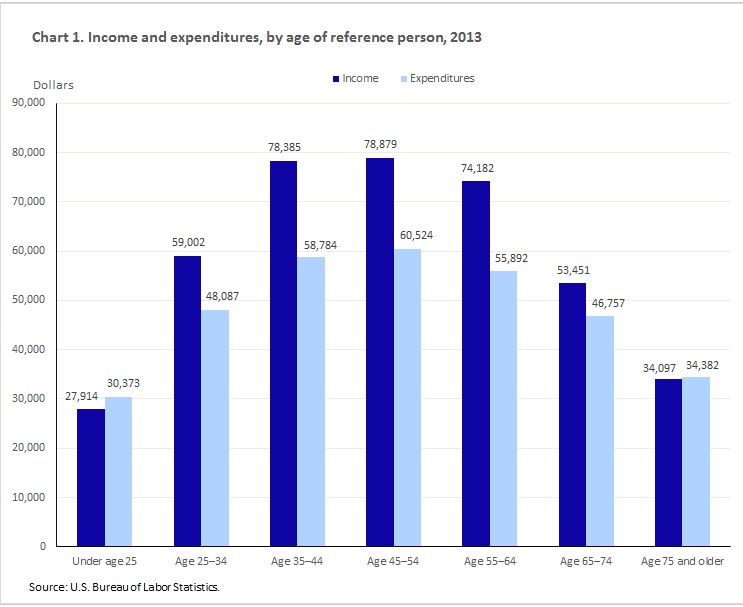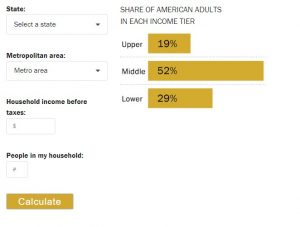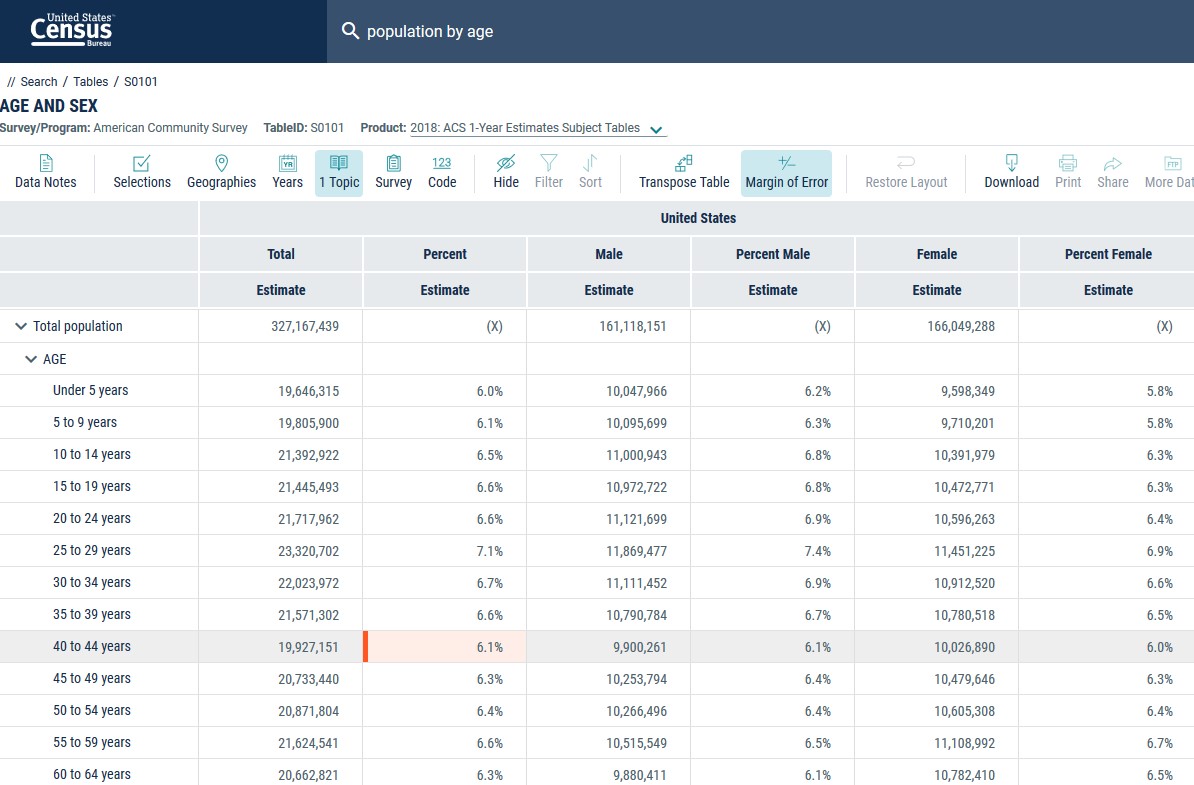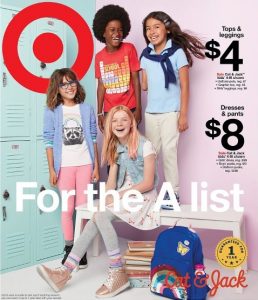Targeting Demographics
One way to define a target is using demographic information. Demographic information might include:
- age
- income
- gender
- family life cycle
Why is demographic information important in targeting? Segmenting your target by demographics helps you determine the potential size of a market, and is a great place to start determining the number of potential customers in your market area.
In the United States, a good starting point for demographic information is the US Census Bureau. The bureau maintains a wealth of information on individuals living in the United States, as you can see in this example below.
Age Demographics
Generation Z
Born 1997-current
Millennials
Born 1981-1996
Generation X
Born 1965-1980
Baby Boomers
Born 1946-1964
Age cohorts define a group of people that were born around the same time period. These cohorts in the US are defined as Greatest Generation, Silent Generation, Baby Boomers, Generation X, Millennials, and Generation Z. People in a cohort, are likely to have shared similar formative experiences over the course of their lives and to respond differently to their environment based on these. Millennials (born between 1981 and 1996), for example, were shaped by the events of 9/11 and the Great Recession as they were coming of age. In addition, Millennials and Z’s are sometimes referred to as Digital Natives because they grew up with a lot of the technology currently in use from a young age.
As cohorts age, they change their buying habits according to their age but also may have some differences from previous cohorts. For example, all cohorts change their purchase behavior as they age and begin to retire. Baby Boomers, however, are so far working a lot longer than those in the previous generation. 40% of early Baby Boomers had not yet retired by 65 as compared with only 20% in the previous generation. (source) https://www.urban.org/sites/default/files/publication/28976/412175-Work-and-Retirement-Patterns-for-the-G-I-Generation-Silent-Generation-and-Early-Boomers-Thirty-Years-of-Change.PDF
Segmenting your target by age can also help you determine the potential size of a market, and is a great place to start determining the number of potential customers in your market area.
According to the United States Census Bureau survey (see figure above), if you were targeting 20-34 year olds, you would know that your starting point for potential customers would be approximately 67 million. From there you could estimate things like awareness, trial, and usage rates to estimate projected sales.

Purchase patterns vary greatly by age so targeting the correct age is important.
Also, age groups are growing at different rates. By 2060, the US population under age 18 is projected to grow by 8.82%, while the population of 45 to 64 is projected to grow by 15.1%.

https://www.census.gov/data/tables/2017/demo/popproj/2017-summary-tables.html
Consider this Tom’s ad and reflect on what the demographic target is and what might a Brand Persona look like.
What is the target?
Toms targets Millennials with an emphasis on social good to align with their values.
Dive Deeper From the Web:
Why Millennials Love TOMS: Insights from Millennial 20/20 Speakers
We talked to TOMS Marketing Director to find out how the brand has won over Millennials by putting giving first, and what they’re planning next as purpose-driven brands multiply… Millennial 20/20 London is next week, and we’ll be there to hear speakers from across industries—including TOMS, Airbnb, BuzzFeed, and Facebook—share their expertise on the future of … Continue reading
Brief persona

Persona starter —Emily is a graphic designer. She is receptive to new ideas and is future oriented. She values authenticity and honesty.
Age demographic targeting can also be practical. It can be a shortcut to finding the audience for your advertising.
If you’re looking for people who are motivated by fair trade and social responsibility, for example, you would find them more easily targeting millennials ( 22 to 38 years old) than targeting boomers (56-76 years old), because more millennials are motivated by these issues.(source)
Dive Deeper from the Web
In 2015, Nielsen polled 30,000 consumers in 60 countries around the world. They wanted to know more about what influences how people feel about brands, and how those feelings impact buying behavior.
One overwhelming conclusion of the report? That across the board, consumers
are willing to pay extra for one thing: sustainability.
This is especially true for Millennials. While 66 percent of global consumers are willing to pay more for sustainable goods, a full 73 percent of Millennials are (Nielsen defines Millennials as those born from 1977 to 1995).
73 Percent of Millennials Are Willing to Spend More Money on This 1 Type of ProductIt’s not even close to avocado toast INC.com.
Income Demographics
Income can be important in many markets. The housing, clothing, and automobile markets, for example, are segmented by income (in addition to other dimensions). In the family car market, a Porsche Macan is an example of a car that is targeted to those with a high income, a Toyota Sienna for a mid income market and a Honda Fit for a lower income market.
High Income**
$163,000 or more
Mid Income**
$55,000 to $162,000
Low Income **
$54,000 & below
**family of 4 in Chicago, IL.
If you’d like to explore how these numbers vary by city and household size, click on “Find out” in the figure on the right to learn more.
"Are you in the American middle class?

Look at the Honda fit ad and reflect on who is the target market and what might a Brand Persona look like.
What is the target?
Brief persona
add comment add comment add comment add comment
Dive Deeper from the Web
The demographic of the Porsche owner, includes a college graduate, household income over $100,000, 85% male, and 15% female. The typical Porsche owner is 40 years old and up with Porsche targeting the 25-54 age demographic seeking a slightly younger audience with the “Engineered for magic, every day” campaign.
How to Segment Your Target Market: A Porsche Success Story
Targeting Gender
The dollar shave club primarily targets men with their advertising. They offered men a no frills easy to shop for experience. Do any women use these razors? Sure. They’re just not the target.
The Nike brand is not entirely targeted to women. In fact the brand has a lot of male oriented imagery. But they’re looking to grow sales with women, and this ad targets them. This is sometimes referred to as a secondary target. With this type of effort, it’s important the communication to the secondary target complements the brand communication and doesn’t alienate the broader target. This ad is aligned with the general Nike branding of “being the best” and “Being the hero in your own story”.
What is the target?
Brief persona
These ads from Toyota, target specific ethnicities based on the idea that people like to be able to see “themselves” in advertising. Be careful when using ethnicity in advertising, however. You don’t want to fall into the trap of offending or stereotyping people
Family Life Cycle
Family life cycle is an important way to segment the market and is used by many products. This is because spending patterns often change at transitional moments in life such as when you are newly independent, new parents, or empty nesters. These transitions are times when brand decisions are often made.
There are many ways to categorize Family Life Cycles. Four common categories are Newly Independent, New Parents, Families with Children, and Empty Nesters.
One decision that new parents make is what to feed their new baby. Look at the Gerber Baby Food ad and reflect on who the target market is and what might a Brand Persona look like.
What is the target?
Gerber is targeting new parents in this ad for Gerber baby food by telling them it’s a trusted brand with some up to date twists to stay current and competitive.
Brief persona

Amanda is a teacher who has been married for two years and is expecting her first baby. She is hard working and supportive of the status quo.
Dive Deeper from the Web
Around this time last year, Nestlé’s Gerber brand wanted to raise awareness and promote trial of Lil’ Beanies, a new product that, in the words of brand manager David Greci, “is a bit of a different proposition from some of our other products.” The navy-bean-based snack for toddlers boasts that it has two grams of protein per serving, is non-GMO and contains no artificial flavors or colors.
One other thing it did not have was a large advertising budget. So Gerber decided to rely on influencers such as Kristy, the creator of a blog dubbed “Mommy Hates Cooking,” to spread the word to the caregivers of its target consumers.
Gerber Among The 86% Of Marketers Using Influencers
This Ford ad targeting Empty Nesters also capitalizes on the idea that life transitions bring new choices for families.
What is the target?
Ford is targeting empty nesters in this ad for the Mustang convertible, teeing up the idea that you’ve done a good parenting job and this might be time to focus on yourself and have a bit of fun.
Brief persona

John












